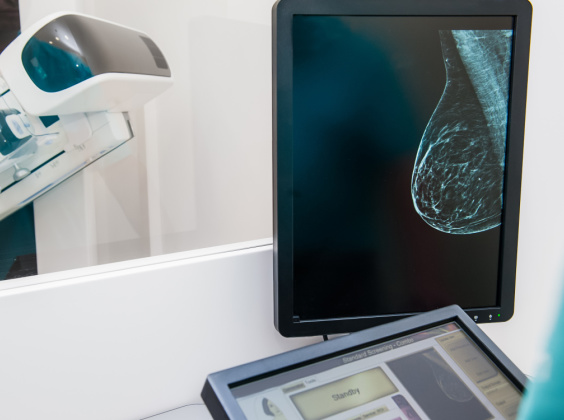
Written by

Cranfield, UK, December 2022 – The breast imaging market in 2022, like most healthcare technology markets, is not yet free of the turmoil induced by the COVID-19 pandemic. Backlogs in breast cancer screening and rising costs, remain pressing concerns for healthcare systems around the world. Breast cancer was the most common cancer globally in 2021, accounting for 12% of all new cases, with disruptions resulting in higher proportions of women presenting cancer symptoms in advanced stages. Hence, alongside efforts to expand access to breast imaging for screening purposes, governments, particularly in developed economies, have increasingly considered prioritising higher-risk patients. Better-designed, more inclusive screening programmes are by no means the only way to address breast cancer mortality, however. Improving the accuracy of breast imaging equipment so that missed lesions and false positives are less frequent is also of central importance for healthcare providers, supporting improved treatment quality and cost-efficiency of services.
Analysis by Signify Research suggests that revenue for the global breast imaging market will exceed $1.3 billion by 2026. However, despite a partial recovery in 2021 from the previous year, the breast imaging market is expected to experience a contraction in market revenue of 9% in 2022. Factors such as rising inflation, increasing costs of energy, shipping and raw materials, as well as shortages of semiconductors have all conspired to produce this decline.
The Evolving Market Dynamics of Breast Imaging
In product terms, we expect to see some sizable changes in market segmentation by 2026. Digital Breast Tomosynthesis (DBT) is one technology for which adoption is set to grow markedly in developed economies as governments seek to improve the effectiveness of screening programmes, excluding the United States where DBT is already prominently used for screening purposes. On the opposite end of the spectrum, there is a forecast decline in lower-end analogue and CR systems in emerging markets with the continued shift to more advanced mammography systems.
Outside of mammography, there are two notable trends in the breast imaging market: the continued importance of ultrasound and the accelerating integration of AI software. Revenues of ultrasound equipment, a modality better suited for imaging dense breast tissue and having dose benefits over mammography, are likely to be primarily driven by countries in Asia Pacific, such as China and Japan. In the case of China, plans to image 90% of eligible women by 2030 serve to reinforce this outlook.

Regional and Sub-regional Trends
The top-level trends in the Breast Imaging market by region are as follows:
- Americas:
- North America: The US is atypical in its widespread utilisation of DBT for screening. For this reason, along with Canada’s intention to follow suit, the North American market will see weakening sales of 2D Full-field Digital Mammography (FFDM) in the coming years to the advantage of 3D DBT.
- Latin America: Remains a price-sensitive market: analogue and computed radiography (CR) sales will continue to be significant by 2026. However, more advanced digital modalities will all gain market share, whereas these will experience less demand year-on-year.
- EMEA:
- Western Europe: The results of prominent trials and studies soon to be released will significantly influence how future screening programmes are designed in Western Europe. Several countries are using supplementary imaging modalities to support mammography and are now transitioning to risk-based profiles and DBT for screening. Thus, greater market fragmentation is observed in Western Europe than in North America.
- Eastern Europe, Middle East, and Africa. In Eastern Europe and the Middle East region, screening programmes are becoming increasingly prevalent. This contrasts with Africa and the Middle East, where financial constraints and the scarcity of facilities often prove prohibitive. An enduring market for analogue and CR systems in Africa makes it a highly fragmented region.
- Asia Pacific:
- Except for Oceania and other developed economies in the region, formalised screening programmes are mostly absent in the Asia Pacific market. Automated breast ultrasound (ABUS) and new DBT systems (excluding upgrades) are among the fastest-growing modalities, with estimated CAGRs of 24.1% and 4.4%, respectively, from 2021 to 2026. Asia Pacific represents a substantial market for ultrasound sales due to having large demographics of eligible women with dense breasts.
The Proliferation of Breast AI
Considerable backlogs, as well as an increasing number of women eligible for breast cancer screening, have provided yet more reason to address the speed and efficacy of screening to detect cancerous lesions at the earliest stages possible. Accordingly, breast imaging AI will likely play a critical role in surmounting these issues by assisting with triage and second reads.
By 2026, the global market for Breast AI tools is estimated to generate approximately $200 million in revenue. While most of the market currently consists of breast AI tools for 2D mammography, tools for DBT will experience significantly faster growth over the coming years. In addition to the burgeoning demand for DBT systems, the slower rate at which the modality’s scans can be read is another factor driving the high growth of DBT AI tools over the forecast period.
Hologic and iCAD accounted for almost three-quarters of the breast imaging AI market in 2021. Both vendors reported growth in their revenues from 2020, indicating a bounce-back from the Covid-19 pandemic.

The Competitive Landscape for Breast Imaging vendors
Despite accounting for the largest share of revenues in the breast imaging market (greater than 40%), Hologic has had a trying year owing to semiconductor shortages. GE HealthCare and Siemens Healthineers, however, have reported strong growth through their respective DBT lines. Fujifilm’s aggressive pricing strategy has helped it maintain its market position, performing particularly well in price-sensitive emerging markets.

General Market Outlook
Market performance is expected to improve by the end of next year as semiconductor shortages gradually subside and measures to bring inflation under control increasingly bear fruit. As breast imaging vendors look to the years ahead, an initial recovery in 2023 should pave the way for sustained growth in most market segments in the medium to long term. In the medium term, the growing adoption of 3D mammography and AI tools will reshape the market landscape, short of completely transforming it; FFDM will remain the largest market segment by 2026. The planned guideline revisions for screening programmes in many countries will include younger women in national screening programmes, increasing the demand for mammography systems, particularly for DBT and FFDM. Risk-based screening is also a significant catalyst in the breast imaging landscape, providing an opportunity for AI vendors to develop supporting tools.
Approaches to breast imaging reporting, too, are changing. Two main trends have emerged: the replacement of standalone breast reporting workstations with consolidated breast reporting applications as part of broader imaging informatics platforms, and a growing proportion of non-emergency imaging being conducted in non-acute settings (i.e., decentralisation of care provision).